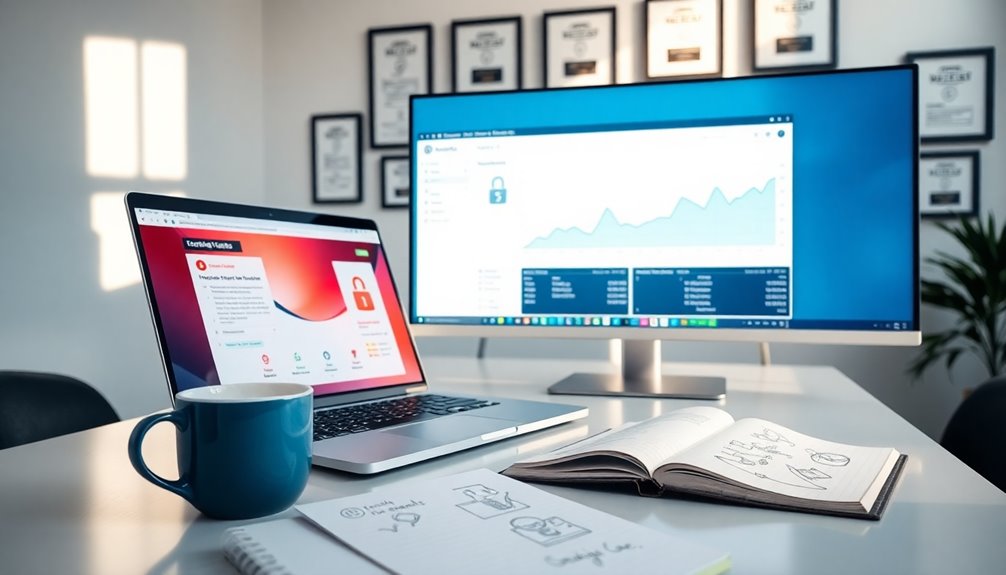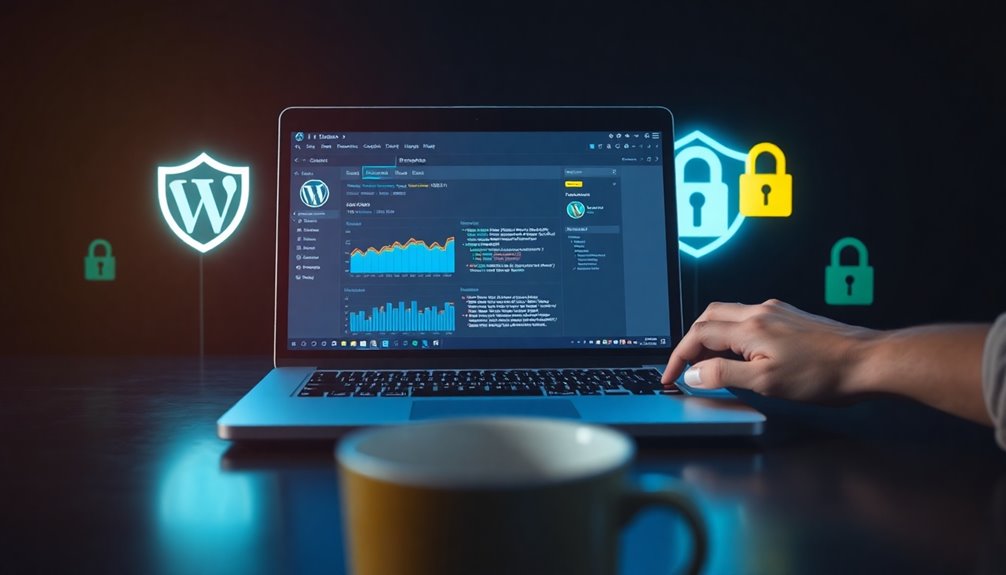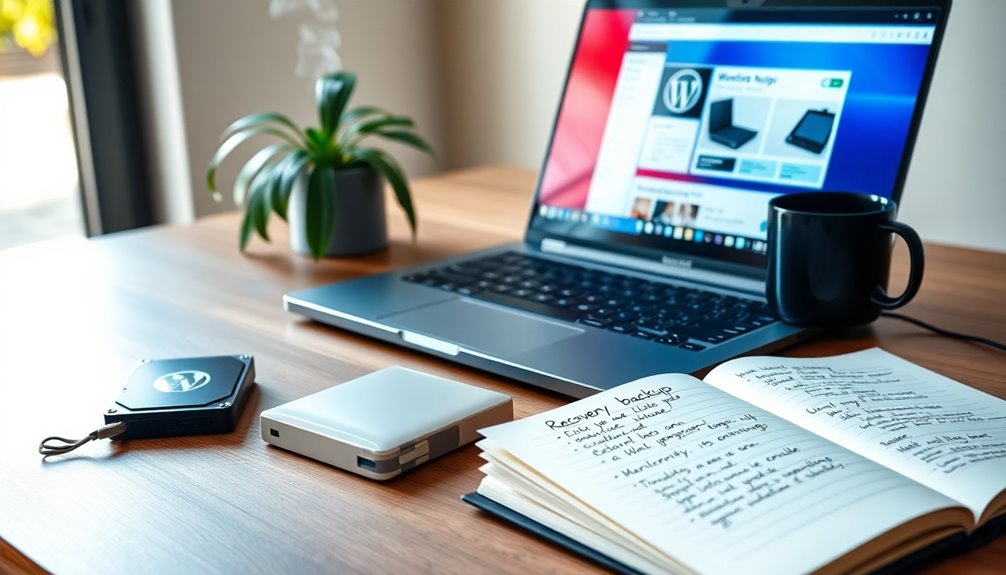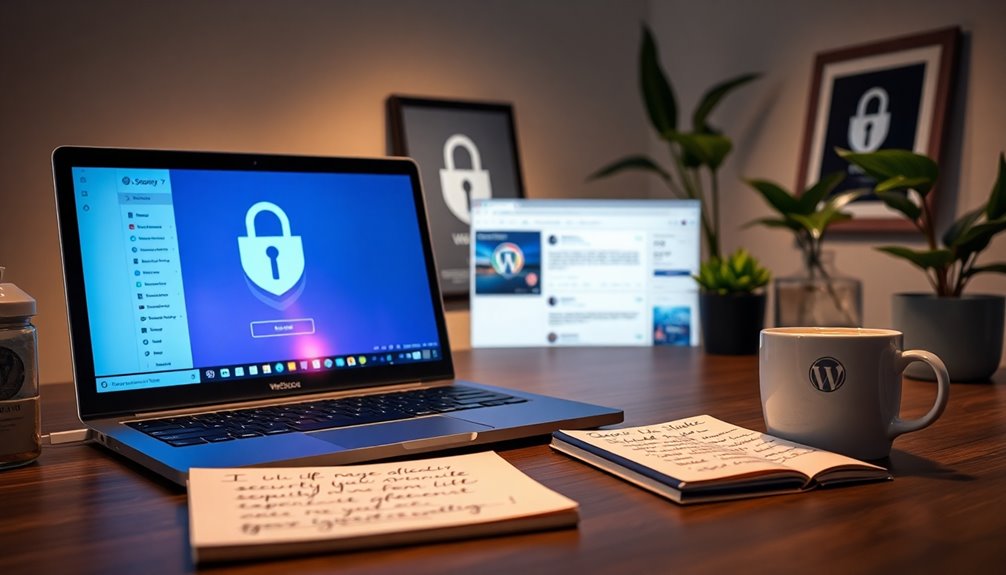To secure your WordPress website in 2024, start by regularly updating your plugins and themes to avoid vulnerabilities. Use strong passwords combined with two-factor authentication to counter brute force attacks. Properly manage user roles, limiting permissions to essential tasks. Protect against common exploits like XSS and SQL injection by implementing security best practices and utilizing security plugins. Don't forget to schedule regular backups to guarantee you can recover swiftly from any incidents. Following these strategies will greatly enhance your site's security. Keep exploring to discover even more vital tips for robust WordPress protection.
Vulnerabilities in Plugins and Themes
When you consider the security of your WordPress site, it's alarming to know that a staggering 97% of security issues stem from vulnerabilities in plugins.
Outdated plugins pose significant risks, as they often lack essential security updates and can harbor malicious code. To guarantee robust WordPress security, prioritize regular audits to identify unnecessary or risky plugins. Implementing tools like MalCare Security Plugin can provide powerful malware scanning and firewall protection. Regular backups using WordPress backup plugins can also safeguard your site against data loss during security breaches.
Tools like Health Check & Troubleshooting can help detect conflicts that expose vulnerabilities. Be especially cautious with nulled plugins; they don't receive critical security patches and can increase your site's risk of exploitation.
Effective plugin management, including timely updates and security patches, is imperative to maintaining a secure environment and safeguarding your site against potential threats. Additionally, regular monitoring of reported vulnerabilities is essential for proactive measures against potential security breaches.
Strong Passwords and 2FA
To keep your WordPress site secure, strong passwords and two-factor authentication (2FA) are essential.
A mix of uppercase letters, numbers, and symbols can make your passwords harder to crack, while 2FA adds an extra layer of protection during logins. Strong password policies combined with 2FA significantly enhance your site's defense against unauthorized access. Additionally, implementing Multi-Factor Authentication (MFA) can further bolster your security measures by requiring additional verification beyond just a password. Moreover, regularly updating your passwords is crucial for maintaining the integrity of your site and preventing unauthorized access.
Importance of Strong Passwords
Strong passwords are your first line of defense against unauthorized access to your WordPress website. They should combine uppercase letters, lowercase letters, numbers, and symbols to effectively counter brute force attacks.
Unfortunately, about 41% of users still neglect strong passwords or 2FA, leaving them vulnerable. Regularly changing passwords and using automatically generated strong passwords can greatly reduce the risk of credential leaks and unauthorized access.
By adopting these security measures, you not only protect your site but also contribute to overall website security. Encouraging reminders and training on the importance of strong passwords can markedly boost user adoption.
Implementing Two-Factor Authentication
Many website owners overlook the importance of implementing Two-Factor Authentication (2FA), which can greatly bolster your site's security. By requiring a second form of verification, like a one-time password (OTP), you substantially reduce the risk of unauthorized access, even if strong passwords are compromised.
Statistics show that 41% of users still don't utilize 2FA, indicating a critical gap in security practices. Combine 2FA with strong, unique passwords to defend against brute force attacks. Encourage user compliance through regular reminders and training sessions about the importance of these verification methods.
Additionally, using password managers can help users create and store strong passwords, making it easier to maintain robust website security alongside effective 2FA implementation.
Brute Force Attack Prevention

Since brute force attacks rely on bots repeatedly trying to guess passwords, securing your WordPress site demands a proactive approach.
Start by using strong passwords that combine uppercase, lowercase, numbers, and symbols to make it harder for bots to crack. Additionally, implementing security plugins can enhance your site's defenses against various cyber threats. Regular use of security audits can help identify vulnerabilities before they are exploited.
Implement the Limit Login Attempts plugin to restrict failed login attempts to three before lockout, greatly reducing unauthorized access risks.
Additionally, change your default login URL to a unique login URL, complicating brute force attempts even further.
Incorporating Two-Factor Authentication (2FA) adds an additional layer of security, ensuring that even if a password is guessed, access remains protected.
Regularly updating your core, themes, and plugins is also crucial to keep your site secure from common vulnerabilities.
Following these WordPress security best practices will help you effectively prevent brute force attacks and keep your site safe.
Managing User Roles
Effective management of user roles is essential for safeguarding your WordPress site, as improper access can lead to serious security vulnerabilities.
By guaranteeing proper role assignment, you can prevent unauthorized changes and data leaks. Here are three key actions to take:
- Conduct Regular Audits: Check user roles frequently to guarantee only authorized personnel access sensitive areas.
- Implement Least Privilege Access: Assign users only the permissions they need for their tasks, minimizing risks. Utilizing a reliable backup solution like UpdraftPlus can further protect your data during this process. Regular backups ensure that your site can be restored quickly in the event of a data loss incident.
- Utilize the User Role Editor Plugin: Customize user roles to align with your security policies effectively.
Additionally, ensure that your backup solutions are robust, as secure backup plugins can further protect your site from data loss and vulnerabilities.
Don't forget to educate your users about their roles.
Understanding access levels can prevent accidental security breaches and promote better security practices, keeping your site safe.
Protecting Against XSS and CSRF

As cyber threats evolve, protecting your WordPress site from vulnerabilities like XSS and CSRF becomes vital.
Cross-Site Scripting (XSS) accounted for over 53% of new security vulnerabilities in 2023, allowing attackers to inject malicious scripts. To combat this, implement Content Security Policy (CSP) headers to control which scripts can run on your site. Regular backups, as part of your security strategy, can help ensure that your site can be restored quickly in case of an attack, making them a critical component of data protection. Additionally, establishing a consistent backup frequency for your site can significantly enhance your recovery capabilities in the event of a compromise.
Meanwhile, Cross-Site Request Forgery (CSRF) exploits user sessions and accounted for nearly 17% of security issues last year. To mitigate CSRF risks, always use CSRF tokens in your forms, ensuring requests come from authenticated users. Additionally, maintain an effective backup frequency to ensure that even if your site is compromised, you have the ability to recover recent data and minimize disruption to your services.
Additionally, regular user education is essential; train your team to recognize phishing attempts and avoid clicking suspicious links, enhancing your overall web security against these threats. Incorporating secure file uploads into your website can further protect sensitive information and prevent malware infections from uploaded files.
SQL Injection Defense
While securing your WordPress site, don't overlook the threat of SQL injection, which accounts for around 20% of hacking incidents.
This vulnerability allows attackers to manipulate database queries and access sensitive data. Here are three key defenses you should implement:
- Use prepared statements to prevent malicious code from being injected into your database queries.
- Regular audits and updates of your plugins can help mitigate potential vulnerabilities.
- Educate your team on secure coding practices and validate all user input.
Additionally, consider utilizing a web application firewall (WAF) to filter and monitor HTTP requests.
Regular Backups and Recovery

Regular backups are essential for safeguarding your WordPress site, especially in the face of potential security breaches or server failures.
To guarantee effective data recovery, consider using automated backup solutions like Jetpack VaultPress, which provide real-time backups of your latest data.
It's important to store these backups in multiple locations, including off-site options, to enhance redundancy and accessibility during a server compromise.
According to industry best practices, regularly testing your backup restoration processes is critical to confirm that you can effectively restore data when needed.
Maintaining recent backups minimizes recovery time and impacts business continuity after cyberattacks, allowing you to get your site up and running quickly.
Prioritize regular backups to protect your online presence.
Using Security Plugins
Implementing security plugins is a crucial step in protecting your WordPress website from various threats.
These tools provide essential features to enhance your site's security, such as:
- Firewall protection to block malicious traffic.
- Malware scanning to detect and eliminate harmful software.
- Two-factor authentication to secure your login process against brute force attacks.
Conclusion
Securing your WordPress site in 2024 is easier than it seems. By implementing strong passwords, using security plugins, and regularly backing up your data, you can greatly reduce risks. You might think, "It's too much hassle," but with clear steps laid out, it becomes manageable. Visualize your security strategy like a shield: each tip you adopt adds another layer of protection. Don't wait—take these steps today to safeguard your online presence and keep your site safe from threats!



